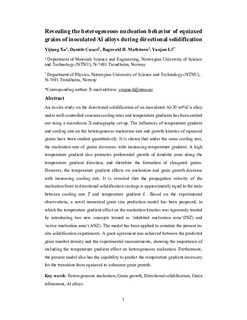| dc.contributor.author | Xu, Yijiang | |
| dc.contributor.author | Casari, Daniele | |
| dc.contributor.author | Mathiesen, Ragnvald | |
| dc.contributor.author | Li, Yanjun | |
| dc.date.accessioned | 2019-02-26T12:52:43Z | |
| dc.date.available | 2019-02-26T12:52:43Z | |
| dc.date.created | 2018-03-20T11:35:23Z | |
| dc.date.issued | 2018 | |
| dc.identifier.citation | Acta Materialia. 2018, 149 312-325. | nb_NO |
| dc.identifier.issn | 1359-6454 | |
| dc.identifier.uri | http://hdl.handle.net/11250/2587493 | |
| dc.description.abstract | An in-situ study on the directional solidification of an inoculated Al-20 wt%Cu alloy under well-controlled constant cooling rates and temperature gradients has been carried out using a microfocus X-radiography set-up. The influences of temperature gradient and cooling rate on the heterogeneous nucleation rate and growth kinetics of equiaxed grains have been studied quantitatively. It is shown that under the same cooling rate, the nucleation rate of grains decreases with increasing temperature gradient. A high temperature gradient also promotes preferential growth of dendrite arms along the temperature gradient direction, and therefore the formation of elongated grains. However, the temperature gradient effects on nucleation and grain growth decrease with increasing cooling rate. It is revealed that the propagation velocity of the nucleation front in directional solidification castings is approximately equal to the ratio between cooling rate Ṫ and temperature gradient . Based on the experimental observations, a novel numerical grain size prediction model has been proposed, in which the temperature gradient effect on the nucleation kinetics was rigorously treated by introducing two new concepts termed as ‘inhibited nucleation zone’ (INZ) and ‘active nucleation zone’ (ANZ). The model has been applied to simulate the present in-situ solidification experiments. A good agreement was achieved between the predicted grain number density and the experimental measurements, showing the importance of including the temperature gradient effect on heterogeneous nucleation. Furthermore, the present model also has the capability to predict the temperature gradient necessary for the transition from equiaxed to columnar grain growth. | nb_NO |
| dc.language.iso | eng | nb_NO |
| dc.publisher | Elsevier | nb_NO |
| dc.title | Revealing the heterogeneous nucleation behavior of equiaxed grains of inoculated Al alloys during directional solidification | nb_NO |
| dc.type | Journal article | nb_NO |
| dc.description.version | submittedVersion | nb_NO |
| dc.source.pagenumber | 312-325 | nb_NO |
| dc.source.volume | 149 | nb_NO |
| dc.source.journal | Acta Materialia | nb_NO |
| dc.identifier.doi | 10.1016/j.actamat.2018.02.058 | |
| dc.identifier.cristin | 1574299 | |
| dc.description.localcode | This is a submitted manuscript of an article published by Elsevier Ltd in Acta Materiala, 1 May 2018 | nb_NO |
| cristin.unitcode | 194,66,35,0 | |
| cristin.unitcode | 194,66,20,0 | |
| cristin.unitname | Institutt for materialteknologi | |
| cristin.unitname | Institutt for fysikk | |
| cristin.ispublished | true | |
| cristin.fulltext | preprint | |
| cristin.qualitycode | 2 | |
